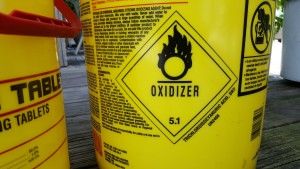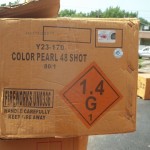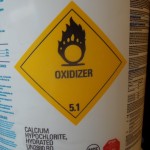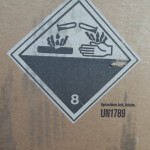The proper use of HazMat labels on a package of a hazardous material offered for transportation will rely largely on compliance with two sections of the USDOT/PHMSA Hazardous Material Regulations in Title 49 of the Code of Federal Regulations:
- §172.406 Placement of labels
- §172.407 Label specifications
It is the latter of these two sections – often overlooked by Shippers and Carriers of HazMat – that is the subject of this article.
First, a warning and a disclaimer: 49 CFR 172.407 contains minute detail about label specifications – especially for color standards – that I see no value in merely repeating verbatim here. In those instances of precise standards, I will refer you to the applicable regulation which should always be your source for compliance.
Also, when reading this article and 49 CFR 172.407, be sure to distinguish when the regulations are referring to the various parts of a HazMat label, which include:
- Background
- Inner border
- Outer border (if used)
- Symbol
- Text (if used)
With that covered, lets look at what standards USDOT/PHMSA has for the HazMat labels on packages of hazardous materials in transportation.
General:
Though the scope of this section of the HMR is not clearly defined, the use of language such as, “whether printed on or affixed to a package” seems to indicate that these specification apply to adhesive-backed labels affixed to a package in the same manner as they apply to the required colors, symbols, text, and numbers printed on a package. This is further clarified by §172.406(a)(1)(i) which requires HazMat labels (with a few exceptions) to be either printed on or affixed to a surface of a package containing hazardous materials.
Each label, whether printed or affixed, must be durable and weather resistant. This general requirement is more specifically explained in the section of this article concerning the color of a HazMat label.
BIG EXCEPTION! §172.407(f) allows for the use of HazMat labels conforming to the specifications in the UN Model Regulations instead of those of the HMR (the subject of this article) except for materials that are poisonous by inhalation.
Contact me with any questions you may have about the transportation of hazardous materials by air, highway, vessel, or rail International and Domestic Daniels Training Services 815.821.1550 |
Design:
§172.411-448 contains images of each HazMat label showing its required appearance except for size and color since the labels displayed are reduced in size and appear in black and white. (The color standards, as I alluded to in the disclaimer, are very precise and will be referenced later whereas the size specifications will be addressed directly). What good are the images of §172.411-448 then? Answer: They show the required printing, inner border, and symbol requirements for each label. Also, unless dimensions are specified elsewhere in the HMR, all features on the HazMat label must be in approximate proportion to those shown in §172.411-448. This includes both the text (if present) and the symbol.
 And while the images display text describing the potential hazard, e.g. FLAMMABLE, this text – except for Class 7 RADIOACTIVE- is not required to appear on the label [§172.405(a)]. Also, the dotted line border shown on HazMat labels in §172.411-448 is not part of the label specification except if it is used as an alternative to the solid line outer border to meet the requirements of §172.406(d), “Each label must be printed on or affixed to a background of contrasting color, or must have a dotted or solid line outer border.”
And while the images display text describing the potential hazard, e.g. FLAMMABLE, this text – except for Class 7 RADIOACTIVE- is not required to appear on the label [§172.405(a)]. Also, the dotted line border shown on HazMat labels in §172.411-448 is not part of the label specification except if it is used as an alternative to the solid line outer border to meet the requirements of §172.406(d), “Each label must be printed on or affixed to a background of contrasting color, or must have a dotted or solid line outer border.”
A HazMat label may contain form identification information, including the name of the label manufacturer provided it complies with the following:
- It is printed outside the solid line inner border.
- It is printed in no larger than 10-point type.
Solely regarding Class 7 RADIOACTIVE materials [§172.407(g)]: The trefoil symbol on the HazMat labels listed below must meet the appropriate specifications in Appendix B to 49 CFR Part 172.
- RADIOACTIVE WHITE-I
- RADIOACTIVE YELLOW-II
- RADIOACTIVE YELLOW-III
Like this article? Subscribe to my Monthly Newsletter No marketing emails! |
 Size:
Size:
A diamond-shaped (square-on-point) HazMat label must be:
- 100 mm x 100 mm (3.9″ x 3.9″) on each side.
- Each side must have a solid line inner border (this is not the outer border that may be required by §172.406(d)) that is 5 mm from and parallel to the edge of the label.
- The width of the inner border must be at least 2 mm.
The size requirements listed just above may be reduced if the following conditions are met:
- A reduced size to the HazMat label must be necessary due to the size of the package.
- The symbol and other elements of the label must remain “clearly visible”.
- The solid line inner border must remain 5 mm from the outside edge of the label and be at least 2 mm in width.
§172.407(c)(iii) & (iv) refer to a transitional exception applying only to the size specifications of a label (just explained above). This is due to a change to the HMR announced in the January 8, 2015 Federal Register to harmonize domestic regulations with the UN Model Regulations. It means that a HazMat label in compliance with the HMR as written December 31, 2014 may continue to be used until December 31, 2016 (so use up that stock!) Whereas, for transportation within the U.S. only, a packaging that is permanently marked with a label in compliance with the HMR as of 12.31.14 may continue in service until it reaches the end of its useful life.
Unless specified elsewhere in the HMR, the hazard class number or division number must be:
- At least 6.3 mm (0.25″) and not greater than 12.7 mm (0.5″) high.
When text describing the potential hazard of a HazMat is displayed on the label (remember §172.405(a)):
- Text must be in letters at least 7.6 mm (0.3″) high.
- For SPONTANEOUSLY COMBUSTIBLE or DANGEROUS WHEN WET labels, the words “Spontaneously” and “When Wet” must be shown in letters at least 5.1 mm (0.2″) high.
Not all HazMat labels are diamond-shaped. The specifications for the CARGO AIRCRAFT ONLY label are as follows:
- Must be a rectangle of at least 110 mm (4.3″) high and 120 mm (4.7″) in width.
- the words CARGO AIRCRAFT ONLY must be in letters at least 6.3 mm (0.25″) high.
Color:
The background color of each label must be as prescribed – not as shown, since the images are black and white – in §172.411-448.
The symbol, text, numbers, and border of a HazMat label must be shown in black except for the following:
- White may be used on a label with a one color background of green, red, or blue.
- White must be used for the text and class number for Class 8 CORROSIVE label.

- White may be used for the symbol for the Division 5.2 ORGANIC PEROXIDE label. If white is used for the symbol, then the solid line inner border on the upper half of the label must be white.
- The transitional exception referred to at §172.407(d)(2)(iii)(B) & (C) refers to a change in the HMR (announced in the January 8, 2015 Federal Register) to the Division 5.2 ORGANIC PEROXIDE label to harmonize with the UN Model Regulations. This change in the HMR is limited to the requirement for the color of the solid line inner border described at §172.407(d)(2)(iii)(A). So, if you have Division 5.2 ORGANIC PEROXIDE labels that were in compliance with the HMR on 12.31.14, then you may continue to use them only until 12.31.16. If you have a packaging permanently marked in compliance with the HMR as of 12.31.14 you may continue to use it until the end of its useful life, within the U.S. only.
- The background color for a Division 2.1 FLAMMABLE GAS label displayed on cylinders and gas cartridges for liquefied petroleum gas may be shown in the background color of the receptacle if adequate contrast is provided. This paragraph was also affected by the rule change announced in the January 8, 2015 Federal Register.
Paragraphs 3 through 6 of §172.407(d) are extremely technical, referring to a 72-hour fadeometer test, color charts on display in the USDOT office in Washington D.C., and the PANTONE® formula guide. I think this is mostly of interest to the printers of HazMat labels and I’m not going to get into that here. As a Shipper or Carrier of HazMat, make certain that the HazMat label printer you are using is in compliance with these regulations.
 Except for the HazMat labels listed below, the specified label color must extend to the edge of the label. For those listed below the label color must extend only to the inner border.
Except for the HazMat labels listed below, the specified label color must extend to the edge of the label. For those listed below the label color must extend only to the inner border.
- Class 8 CORROSIVE
- Class 7 RADIOACTIVE YELLOW-II
- Class 7 RADIOACTIVE YELLOW-III
A HazMat label must be able to withstand a 30-day exposure to conditions it is likely to experience during transportation – Shippers, you have to know this! – without a deterioration or substantial change in color. This is the “30-Day Exposure Rule” that also applies to placards at 49 CFR 172.519(a) though, curiously, not to HazMat package markings.
Had enough? As a Shipper of hazardous materials, it is not enough for you to assume the supplier is providing you with HazMat labels that meet the above specifications, you must be sure. At a minimum, ask your supplier to certify that they are in compliance with the HazMat label specifications of 49 CFR 172.407. If their answer is, “Huh?” you might want to find another supplier.
Daniels Training Services 815.821.1550 |


